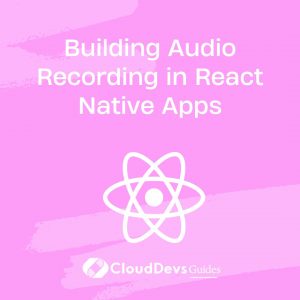Add audio recording in React Native
Are you ready to amplify the auditory experience of your React Native app? Look no further! In this guide, we’ll dive into the fascinating world of audio recording within React Native applications. From setting up the basics to implementing advanced features, we’ve got you covered. Let’s embark on this sonic adventure together!
Getting Started
Before we delve into the nitty-gritty of audio recording, let’s ensure our development environment is primed for action. First things first, make sure you have Node.js and npm installed. Then, set up your React Native project using Expo or React Native CLI.
Setting Up Audio Recording
The foundation of audio recording lies in accessing device hardware capabilities. Fortunately, React Native provides robust libraries like react-native-audio-record and react-native-audio-recorder-player to facilitate this process. Simply install these libraries via npm or yarn and follow the documentation to integrate them into your project.
Capturing the Sound Waves
With the setup complete, it’s time to capture some sound waves! Utilize the APIs provided by the chosen libraries to initiate, pause, resume, and stop audio recording sessions within your app. Don’t forget to handle permissions gracefully to ensure a seamless user experience.
Enhancing the Experience
Now that we’ve conquered the basics, let’s elevate the audio recording experience with some advanced features:
- Audio Playback: Enable users to listen to their recordings directly within the app using playback functionality. Integrate features like play, pause, seek, and volume control to provide a comprehensive audio playback experience.
- Waveform Visualization: Impress your users with visually stunning waveform representations of their recordings. Utilize libraries like react-native-svg to render waveform graphs that mirror the intensity and frequency of the recorded audio.
- File Management: Implement robust file management capabilities to organize and manage recorded audio files effectively. Provide features for renaming, deleting, and sharing recordings to empower users with full control over their audio content.
Real-World Examples
To provide practical insights into audio recording in React Native apps, let’s explore some real-world examples:
- Voice Memo App: Imagine building a voice memo app that allows users to effortlessly record, playback, and manage their voice notes. Incorporate features like categorization, tagging, and cloud synchronization to take the user experience to the next level.
Voice Memo App Example - Music Player with Recording Capability: Combine the power of audio recording with a fully-fledged music player to create a versatile audio application. Enable users to record their musical creations, edit them on the fly, and seamlessly integrate them into their playlists.
Music Player Example - Podcast Recording Studio: Develop a podcast recording studio app tailored for podcasters on the go. Empower users to record interviews, add background music, and apply audio effects to produce professional-quality podcasts directly from their mobile devices.
Podcast Recording Studio Example
Conclusion
Congratulations! You’ve successfully embarked on a journey to master audio recording in React Native apps. Armed with the knowledge and tools provided in this guide, you’re well-equipped to create immersive audio experiences that captivate your users. So go ahead, unleash the sound, and let your creativity soar to new heights!
External Resources
Happy coding, and may your apps resonate with brilliance!
Table of Contents









